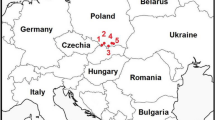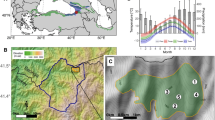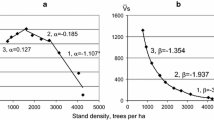Abstract
The change in the stand structure with recovery after gap formation was analyzed by using the diffusion equation for a primary warm-temperate evergreen rain forest on Yakushima Island of southern Kyushu, Japan. The tree density in dbh classes, the mean growth rate of dbh and the variance of dbh growth rate in closed stands and gaps were expressed as functions of dbh. The change in dbh frequency calculated from these functions and the observed tree mortality clarified the fact that the dbh distribution in the closed stands is rather stable but becomes more positively skewed with time. Attention was also paid to the change in stand basal area (BA) in 20m×20m plots. The log-normal distribution expressed the frequency distribution of BA in the forest as a whole. The growth rate of BA in plots without new gap formation was formulated as a function of BA. Gap formation rate observed in 0.8 ha closed stands in recent four years was 1.3% per year. This rate agreed with the result of calculations based on the assumption that the frequency distribution of BA is stationary with time.
Similar content being viewed by others
References
Brokaw, N.V.L. 1985. Treefalls, regrowth, and community structure in tropical forests.In: S.T.A. Pickett and P.S. White, ed., The Ecology of Natural Disturbance and Patch Dynamics p. 53–69. Academic Press, Orlando.
Grubb, P.J. 1977. The maintenance of species-richness in plant communities: the importance of the regeneration niche. Biol. Rev.52: 107–145.
Hara, T. 1984a. A stochastic model and the moment dynamics of the growth and size distribution in plant populations. J. theor. Biol.109: 173–190.
— 1984b. Dynamics of stand structure in plant monocultures. J. theor. Biol.110: 223–239.
Kohyama, T. 1986. Tree size structure of stands and each species in primary warm-temperate rain forests of southern Japan. Bot. Mag. Tokyo99: 267–279.
—,K. Sakamoto, T. Kobayashi andR. Watanabe. 1984. Structure of tree community of a primary lucidophyll forest in the Koyohji basin.In: M. Numata, ed., Conservation Reports of the Yakushima Wilderness Area, Kyushu, Japan p. 375–397. Environment Agency of Japan, Tokyo (in Japanese).
Levin, S.A. andR.T. Paine. 1974. Disturbance, patch formation, and community structure. Proc. Nat. Acad. USA71: 2744–2747.
Nagano, M. 1978. Dynamics of stand development.In: T. Kiraet al., ed., Biological Production in a Warm-temperate Evergreen Oak Forest of Japan. JIBP Synthesis18: 21–32. Univ. of Tokyo Press, Tokyo.
Naka, K. 1982. Community dynamics of evergreen broadleaf forests in southern Japan I. Wind damaged trees and canopy gaps in an evergreen oak forest. Bot. Mag. Tokyo95: 385–399.
Paine, R.T. andS.A. Levin. 1981. Intertidal landscapes: disturbance and the dynamics of pattern. Ecol. Monogr.51: 145–178.
Sinko, I.W. andW. Streifer. 1967. A new model for age-size structure of a population. Ecology48: 910–918
Author information
Authors and Affiliations
Additional information
To the memory of Dr. Kazuo Naka, who has been one of the most active researchers in this field of study and who passed away at the age of thirty-five in February 1987.
Rights and permissions
About this article
Cite this article
Kohyama, T. Stand dynamics in a primary warm-temperate rain forest analyzed by the diffusion equation. Bot. Mag. Tokyo 100, 305–317 (1987). https://doi.org/10.1007/BF02492837
Received:
Accepted:
Issue Date:
DOI: https://doi.org/10.1007/BF02492837




